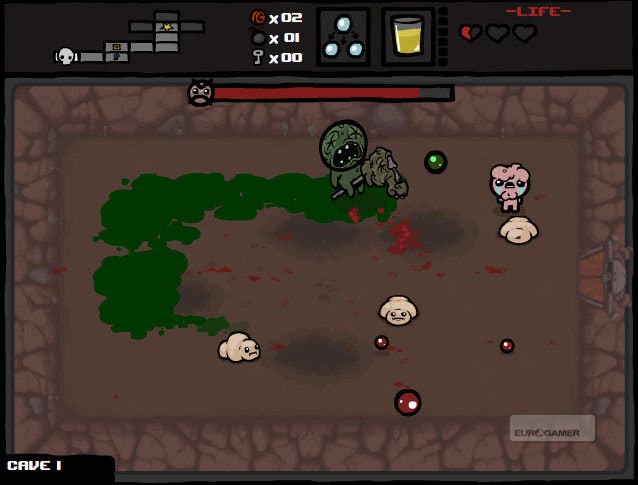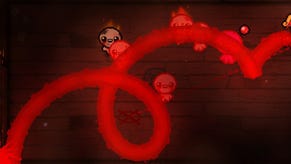The Binding of Isaac
Randomness is next to godliness.
The Binding of Isaac takes liberties as it modernises the Bible story of the same name, but the gist remains: God is a total control freak.
Our hero, Isaac, is just an awkward kid who wants to play Game Boy in peace. One day, his mom gets a message from her Lord that He'd like her to turn off the TV and kill her son, as a gesture of her appreciation for Him. (Jeez, the ego on This Guy.) Mom grabs a steak knife, happy to oblige the request. That's when Isaac spots a trap door into the basement and takes the plunge. It's godless down there, but at least he'll live.
For a while, anyway. The game's subterranean world is populated by a parade of horrors, like ravenous maggots that lunge at Isaac with teeth bared and incontinent golems who scald him with hot urine. It all would be too grotesque if Binding weren't co-designed by Edmund McMillen, whose cartoony art style turned a skinless lump of sinew into an adorable gaming icon with last year's Super Meat Boy. So yes, the floors are strewn with blood and faeces; damn if they aren't the cutest blood and faeces you've ever seen, though.
Your quest is to descend through six or more increasingly difficult dungeons (although it's not clear what fate awaits you at the end). The terrain is laid out like the original Legend of Zelda on the NES: you explore one monster-filled, trap-laden room at a time, and each room takes up the entire screen.
Indeed, the natural first impression of Binding is that it's practically a Zelda clone. The health meter is a chain of heart icons. Your offensive options are made up of a standard attack and a special weapon. You collect coins to buy things (or gamble), bombs to wreak general mayhem, and keys to open doors or treasure chests.

Still, maybe Nintendo Legal should hold off before they draft that cease-and-desist letter. Did I mention that Isaac attacks enemies by blinking his tears at them? Link never did that. And come to think of it, I don't recall that Link ever gobbled down unlabelled prescription medication, or tattooed "666" on his forehead to boost his damage stats, or pacified enemies by smothering them in his mother's bra, either.
Sounds depraved, but Isaac is desperate. He'll take any edge he can get, because when that heart meter hits zero, that's it. There are no wussy continues or save points in Binding. You have to complete the game from start to finish in one shot. It takes about an hour if you succeed, and if you don't, back to the beginning.
That's when the real twist of Binding reveals itself. You hit "Replay" and suddenly, everything's different. The game never plays the same way twice, generating itself anew for every playthrough. So McMillen and co-creator Florian Himsl didn't design the dungeons per se. Rather, they crafted the general guidelines within which the computer designs the dungeons, at random, every time you start a new game.

Game-design wonks call it procedural generation or "roguelike" design, and it has been used most famously in the longstanding cult hit NetHack, plus more recent games like Desktop Dungeons and Spelunky. Binding, however, is the most accessible exploration of the roguelike idea that I've seen.
From the baseline of the simple Zelda template, each visit to The Binding of Isaac develops organically into a distinctive experience. The game possesses a huge array of weapons, power-ups, monsters, mini-bosses, treasures, and traps. Even if you conquer all of the dungeons on a given playthrough, you'll only see a fraction of the possibilities.
Of course, it's easy to lard your game with options if sheer quantity is the goal, but McMillen and Himsl have been more discriminating than that. Their philosophy seems to be that a new idea only gets tossed into the random generator if it's fun.









